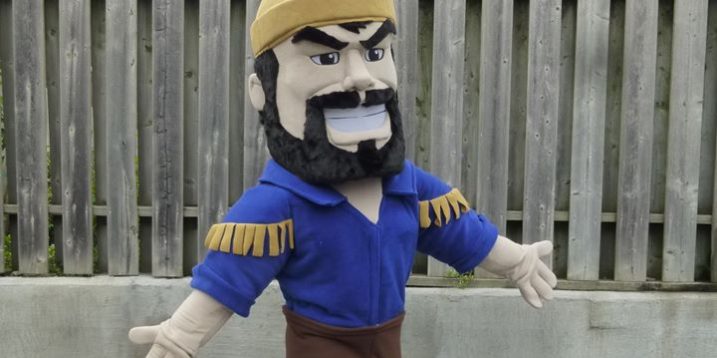By Joel Belliveau, Associate Professor of History, Laurentian University
It has been alleged that Victor the Voyageur, the Laurentian University varsity teams’ mascot, is a “symbol of colonisation” and “represents a racist history” (Lambda, Jan 13, 2020). The idea of getting rid of Victor has also been justified with the argument that “not everybody feels represented by a mascot that depicts a white man.” This discussion – and these two arguments – has struck a chord with me both as a historian and as a member of a minority group.
I’ll put my historian hat on first. While voyageurs were among the first sizeable group of people of European descent to spend time in what we call northern Ontario (and in much of the North American North West), is it fair to frame them, in the historical record, as active agents of colonial oppression for Indigenous nations?
The voyageurs were traders, rugged men who lived an independent life, yet still “worked for the man” going to and fro among numerous Indigenous communities by canoe in order to trade with them, exchanging manufactured goods (such as pans, clothing, metallic tools and firearms) for pelts. They travelled all over what the French settlers of New France called “les pays-d’en-haut,” or the “upriver lands,” encompassing all of the upper Saint Laurence and the Great Lakes and, later, the western plains too. The French did not do much in terms of settlement in this gigantic area. Rather, they largely left it to their Indigenous trading partners. Their permanent presence in the area was limited to a string of small forts, used mostly for trading with Indigenous allies and discouraging incursions from the British to the South-East. At any given moment, the French in les pays d’en haut were vastly outnumbered and, yes, militarily inferior to the First Nations peoples. French settler colonists, for their part, were largely limited to the St. Lawrence River valley and the Bay of Fundy area.
LU confirms Victor the Voyageur, university’s mascot, under ‘review’
To establish whether the voyageurs were agents of colonialism despite their shallow footprints on the land, we might look at how they were depicted by French colonial authorities. Fact is, the latter decidedly did not see the voyageurs as their cultural agents, and did not imagine that they would bring European “civilisation” to Indigenous peoples. Quite the contrary! The voyageur lifestyle was long seen as highly undesirable. They needed a permit to engage in this trade because the king wanted his subjects to be settlers, to cultivate the land and to make the Laurentian colony grow. In 1696, King Louis XIV despaired publicly, in a brief, at seeing young men “race into the depths of the forest, where they contract all sorts of habits of debauchery and vice which render them useless” and unproductive. Their nomadic spirit and disdain for settling down made them suspect, and they were seen as libertines. Rather than influencing the Natives, they were perceived as becoming less and less Christian and French themselves. As late as 1756, French philosopher and military man Marquis de Mirabeau remarked that their experiences made them “incapable of the subordination that is the spirit of any colony.” Finally, they were notoriously unpatriotic. Merchants to the core, they would not hesitate to deal with France’s English rivals on the Hudson Bay if they offered a better price, or simply to avoid a long trip back to Montreal.
Value judgements aside, these authorities were not wrong. Many of the voyageurs were less and less like Europeans and more and more like the First Nations they dealt and lived with for much of the year. For many men, becoming a voyageur was a means of making a living, but also of escaping the social regulations that church, state and seigneurs exacted on peasant populations. This was alluring, and so were many elements of First Nations’ cultures. To the point, of course, that the voyageurs’ intermingling with the Cree, Anishinabek and others gave rise to Michif languages, to Métis communities in many areas, and to a Métis nation in the prairies. After the Conquest of New France, some English and Scottish men also became voyageurs, as well as part of the Métis people. It is interesting to note that, culturally speaking, the voyageur existed at the intersection between the societal groups and languages that define the Laurentian University as a bilingual and tricultural institution today.

But there remains that pesky question of their role in colonisation, that is to say in ending the First Nations’ traditional ways of life. Except they didn’t have a significant part in that. At the time of the voyageurs, the First Nations remained keepers of the land and kept on living much as they did before, with the difference that trade with the voyageurs (and the far-away companies they represented) provided them with new resources. The trading relationship was a balanced one, since the voyageurs were not on their own turf, and the Indigenous women and men who took part in it had much agency, and often gained influence from it. And Indigenous people could still depend on their traditional activities to live, and shun trade if they wished, although it is true that gradually, some voyageurs became part of their communities.
In my opinion, this was not a dynamic of colonialism. I’d be happy to entertain arguments to the contrary, but up until now, arguments have not been put forward, only gratuitous claims – claims based on what would happen later.
It was only in the 1870s and 1880s that the traditional indigenous economy would be quasi-eradicated in northern Ontario and the Western plains, falling prey to the instruments of surveyors, land development schemes, migrations, and the commerce of forest products and wheat, all of which were bolstered by the Canadian Pacific Railway and telegraph. By then, the voyageurs and the fur trade would be long gone too, victims of the same developments. It’s not a coincidence that the 1870s and 1880s are also the decades that saw the appearance of the “numbered treaties” of the infamous Indian Act and of the first residential schools. This was, most certainly, colonialism.

The people who have suggested that the voyageurs are symbols of colonialism are well intentioned, but have oversimplified this part of our past. Getting rid of Victor will do nothing for the Indigenous nations of northern Ontario whose have been marginalised and pauperised by state and industry since the mid-nineteenth century. It will simply erase from memory one rare part of our common history that we need not renege. Our time and energy would be better used in trying to understand how colonial mindsets are still at work today, still hindering the establishment of an egalitarian relationship with Indigenous peoples
Victor, inclusion and exclusion – a dilemma of representation in our age
Now, let’s broach, more succinctly, the issue of representation. Can a white, bearded man be a symbol for a diverse university whose student body includes a majority of women and growing populations of Indigenous and international students? I confess that I am more ambivalent about this part of the story. Admittedly, contrary to an animal, Victor represents a specific kind of human, and therefore, women or members of ethnic or even religious minorities may not identify spontaneously with him. That may well be reason enough to can him. However, allow me to play devil’s advocate for one minute.
First, let us note that at the very least, the Victor case does not represent cultural appropriation. Teams with names like “Red Skins”, “Indians”, “Black Hawks”, etc. have changed their colours and so should they. But Victor is not guilty of this kind of racist offence.
Secondly, are we so certain that international students are so repelled by any sign of local history? Are we so sure they are hoping to come to an institution and a town devoid of any particularities or local flavour? Embracing newcomers, in my mind, is not about hiding our history under the mat; it is rather about welcoming them into this history, helping them make it such that their story can join with ours. It is also about getting acquainted with their origins and beliefs, and figuring out when and where accommodations are in order. In short, it is an encounter, an encounter not unlike the one between the voyageurs and the First Nations, so long ago.
Thirdly, well … Victor is a man. I admit that might be problematic. Can a fix be found? I hear there was once a female counterpoint to Victor, “Lady V.” Would this be palatable to our varsity female athletes and fans? That is not for me to say.
Finally, let me broach what is most probably at the foundation of my unease with this suggestion. If we get rid of Victor in the name of inclusivity, we will also (inadvertently), marginalise at least one minority: the francophone community. Are we forgetting that Franco-Ontarians had been trying to set up their own university for years when Laurentian was founded in 1960? That the Ontario government denied them their own institution and offered, rather, an undefined bilingualism as a compromise? Are we forgetting that sixty years later, the French fact still can’t quite find its place in Laurentian’s halls? If we push Victor aside, it is one more symbol of this school’s original spirit of conciliation that will be lost, and one of the few remaining visible signs of its French Canadian heritage.
